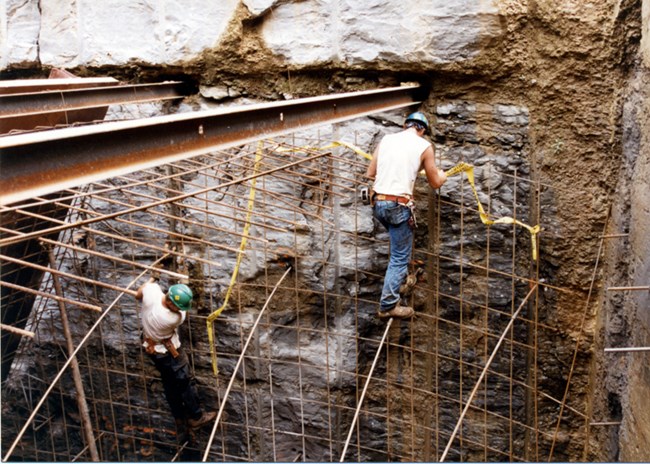|
Visit our keyboard shortcuts docs for details
This is an older video that shows how the Double Arch Bridge was constructed. 
U.S. Department of Transportation Federal Highway Administration One of the most challenging engineering projects along the Trace was the construction of a bridge that spans a scenic valley and Tennessee Route 96, about 8 miles west of Franklin, Tennessee. Meeting this challenge required a design to minimize or eliminate adverse impact to the natural environment while maximizing enjoyment and safety of the traveler. The most aesthetically pleasing design called for construction of a bridge with open arches, mimicking the hilly terrain nearby. The resulting 1,648 foot-long Double Arch Bridge, offering motorists a view 155 feet above the pristine valley below, comprises one of the most important links toward the final completion of the Parkway. 
U.S. Department of Transportation Federal Highway Administration Foundation InvestigationThe construction effort started with studies of the structure’s foundations. The foundations were supported on a rock layer locally known as the Brassfield limestone. Field borings indicated that the limestone lies about 30 feet below the existing ground surface and may contain cavities. Since the arch foundations must resist large vertical and horizontal loadings, the integrity of the underlying limestone was critical. The investigation of possible cavities was performed using a method known as Crosshole Seismic Scanning and Tomography. By using strategically placed transmitters and receivers to measure seismic velocity and wave attenuation, a tomographic image of the foundation material was created which enabled engineers to map the entire foundation area. As a result of the crosshole seismic study, a cavity was discovered at the base of one of the piers and its location and size determined. This study enabled the designers to include in the plans and specifications the construction details needed to accommodate this cavity.Arch DesignOne interesting feature of the bridge is the way the weight of the roadway superstructure is applied to the arch. Normally in arch bridges, the superstructure is connected to the arch by a number of evenly spaced vertical members called spandrel columns. This procedure permits the weight of the superstructure to be transmitted evenly along the length of the arch. In an effort to create a cleaner, less cluttered appearance, the Double Arch Bridge was designed without spandrel columns. The result is that the weight of the superstructure is concentrated near the crown of the arch instead of being distributed evenly along the arch length. Sophisticated computer programs were used to analyze the arches to ensure that they would react properly when the weight of the superstructure was applied. In an effort to verify the correctness of the computer analysis, strain gauges were embedded within the concrete of the arch and monitored during construction. The strain gauges measured the stresses in the arch caused by its own weight, superstructure weight, and temperature changes. The actual stress was compared to those stresses predicted by the computer model used during the design of the structure to ensure agreement.Unique Construction TechniquesThe bridge was built using a combination of concrete precast and cast-in-place segments. The precast segments, weighing a maximum of 55 tons apiece, were constructed offsite in a plant under controlled conditions. The segments were transported to the site where they were assembled together to form the arches and superstructure of the bridge. The remainder of the bridge was built by cast-in-place construction, which means that the segments were constructed in their final position. This method of construction also was used to build the piers.The precast arch segments and the superstructure segments were lifted into place by a large groundmounted crane. The arch segments were supported by cable stays until the arch was fully constructed. The superstructure segments were placed alternately on either side of a support point (pier or arch) using a construction method known as balanced cantilever (seesaw-like) erection. Together, 196 superstructure segments and 122 arch segments were cast and erected to complete the structure. The Double Arch Bridge of the Natchez Trace Parkway, completed in May 1994 and selected for a Presidential Award for Design Excellence in 1995, became our Nation’s first segmentally constructed concrete arch bridge. |
Last updated: October 3, 2022
